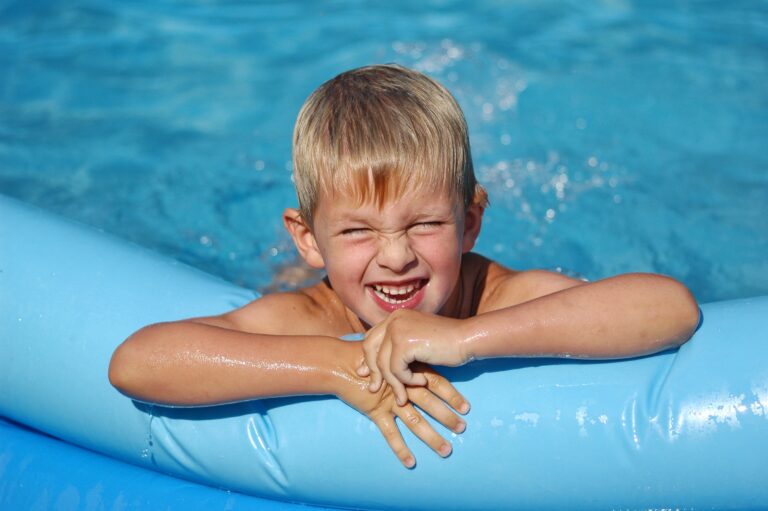Waterproof sun protection

Whether you are on a beach holiday, surfing or snorkeling, waterproof sun protection is a must for these and similar activities. The products must adhere well and should not be easily rinsed off by sweat or water. After all, the water surface is not a real barrier to the sun’s harmful UV-B rays: At a depth of one metre, the intensity is still up to 70 per cent. In addition, the radiation at the seaside is significantly higher than when walking through the city, for example, due to the reflection of water and sand.
In order for waterproof sun protection to be fully effective, there are a few things to keep in mind. Under no circumstances should the product be used sparingly when applying it. According to the international standard, the rule of thumb is: two milligrams of waterproof sun protection are needed per square centimetre of skin. Extrapolated, the optimal consumption per person and week is approximately 200 millilitres. Particular care should be taken with areas of the body that are directly exposed to sunlight. These so-called terraces include, in particular, the forehead, nose and tips of the ears, décolletage and shoulders, but also the back of the feet and knees. However, waterproof sun protection is also important for the areas around swimwear or beachwear. In addition, the skin areas under clothing should be creamed if the clothing is not explicitly UV-proof.
Can I rely on waterproof sun protection to really protect me?
Waterproof sun protection should have the highest possible sun protection factor, because only then can it protect against premature skin aging, skin damage and skin cancer.
But is the SPF indication really a guide or just a marketing strategy? Consumers can be completely unconcerned here, because waterproof sun protection is also subject to strict guidelines. The basis for the standards is the ISO 24444 standard, which is valid worldwide and regulates the determination of the sun protection or light protection factor. ISO is the abbreviation for the ‘International Organisation for Standardisation’, an umbrella organisation that specialises in the development of voluntary international standards and was founded in Switzerland in 1947. The organisation now has 165 member countries. So when a sunscreen is labelled as waterproof SPF 50, end users can rely on ISO 24444 to ensure that this sun protection factor is actually guaranteed. All other manufacturing processes in a company are also subject to a standard, namely ISO 9001, a standard for quality management systems.
Nevertheless, it should be noted that waterproof sun protection can only protect for a limited time. Depending on how much time a user spends in the water or in the shower, it is advisable to reapply the product. In addition, the European Cosmetics Association Colipa makes a clear distinction between the terms ‘waterproof’ and ‘extra waterproof’. If half of the sun protection factor can still be measured after two standardised bathing sessions of 20 minutes each, a product may be labelled as ‘water resistant’. By contrast, the label ‘extra waterproof’ is only permitted for those products in which half of the sun protection factor can be measured after four standardised bathing sessions of 20 minutes each.
Waterproof sun care: Which UV filters are recommended?
Sun protection can contain mineral or chemical UV filters. At Cosmacon, we only recommend mineral filters based on zinc oxide for natural cosmetics. Chemical filters should always be free of nano-particles, photostable and free of any potential hormonal effects. Cosmacon’s waterproof sun protection only contains lipid-soluble UV filters, because the known water-soluble filters are washed out far too quickly. Four good examples are given below:
INCI: Ethylhexy Triazone
CAS number: 88122-99-0
molecular formula/molecular weight: C48H66N6O6 = 823.09
escription: a liposoluble chemical UV filter
advantages: is considered to be stable and very safe, provides additional protection against free radicals
INCI: Bis-Ethylhexyloxyphenol Methoxyphenyl Triazine
CAS number: 187393-00-6
Molecular formula: C38H49N3O5
Description: a chemical UV filter that is also suitable for sun-sensitive people
Advantages: stable and safe, rarely causes allergic reactions, can also counteract premature skin aging
INCI: Diethylamino Hydroxybenzoyl Hexyl Benzoate
CAS number: 302776-68-7
Molecular formula: C24H31NO4
Description: a UV filter of synthetic origin that is considered recommendable
Advantages: stable, completely harmless to health at a maximum concentration of ten per cent
INCI: Diethylhexyl Butamido Triazone
CAS number: 154702-15-5
Description: a soluble organic UV-B filter
Molecular formula: C44H59N7O5
Advantages: absorbs UV-B rays from 280 to 320 nm, is one of the most photostable chemical filters available
Water-resistant sun protection: important information
To ensure that water-resistant sunscreen is actually water-resistant, polymers are added to the formulation. However, these feel heavy on the skin and make the product more difficult to spread. In addition, the test costs for the supplier are virtually twice as high. As an alternative to water-resistant products, Cosmacon therefore recommends re-applying the cream every two to three hours.
Can water-resistant sun protection cause vitamin D deficiency? This fear is quite persistent. However, not using sunscreen is a poor solution for preventing vitamin deficiency. The negative consequences of UV rays clearly outweigh the risks here. After sunbathing, you should always take a thorough shower. Afterwards, it is recommended to apply a high-quality after-sun product that contains a high concentration of antioxidants.
High-quality waterproof sun care from Cosmacon
Sun protection is essential! It protects against skin damage, premature skin aging and cancer. This makes it all the more important to rely on high-quality and sophisticated formulations. Is good, waterproof sun protection still missing from your product line? Let Cosmacon develop modern formulations to the highest standards!